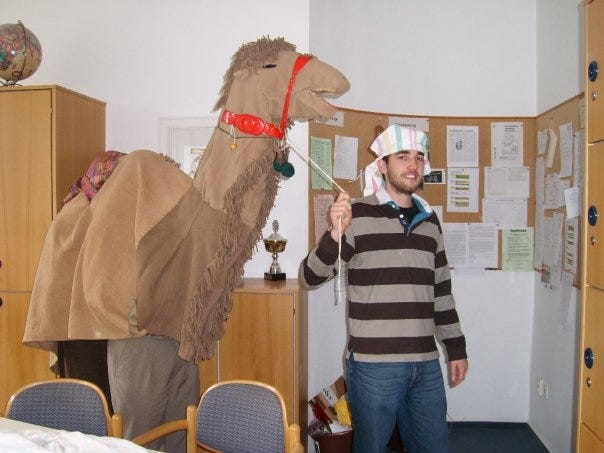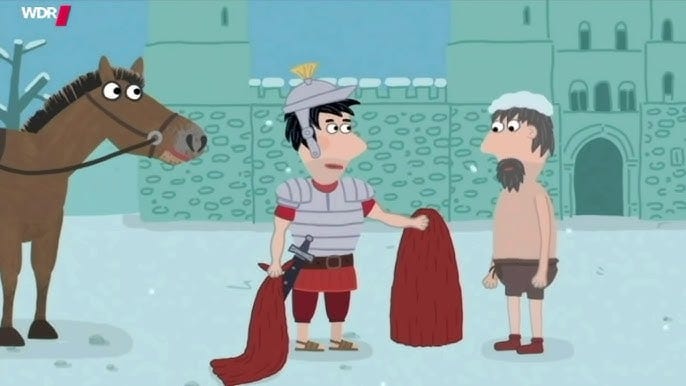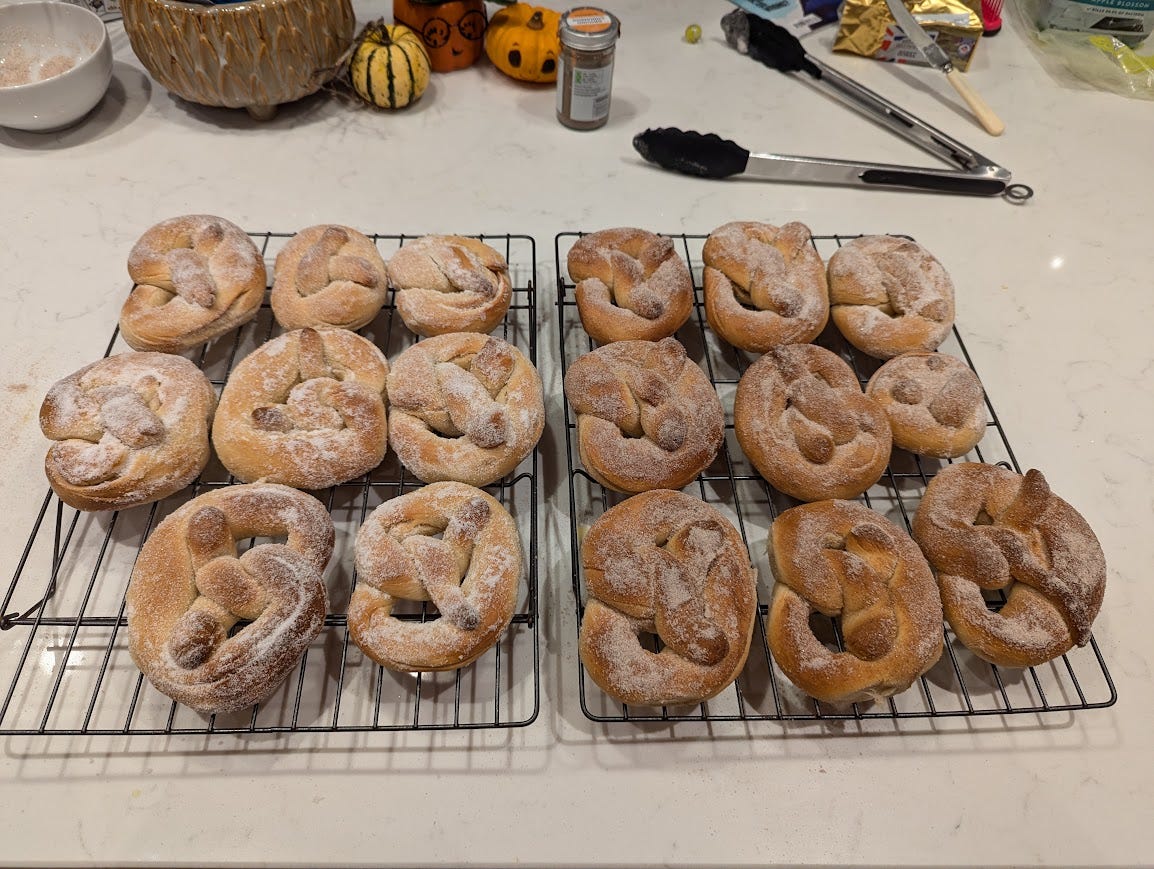Martinstag
Whilst Brits are donning their poppies for Remembrance Day, Germans have very different traditions
After the somewhat depressing subject matter of my last post on the collapse of the German government coming on the same day Donald Trump was re-elected, I thought I would choose more cheery subject matter for my next piece.
The 11th minute of the 11th hour on 11th month… not silence but the over-excited screams of children and teenagers, running around with painted faces and fancy-dress costumes, blowing trumpets, and releasing party streamers. This was nowhere in England of course, but my first November living in Germany.
In many parts of Germany this is the official beginning of carnival season (Karneval or Fasching depending where in Germany you are) which culminate in the grand parades in February or March before the beginning of Lent.
Being a particularly Catholic region where I lived, carnival was serious business. At the school where I worked, lessons were temporarily halted for celebrations in the hall. Having only been in the country for a couple of months at this point I had very little idea what all this madness was in aid of. At one point I was made to dress as a camel herder and lead the Head Master and Deputy Head, dressed as the front and rear parts of a camel, around the building.
I had started that day wondering whether I should wear a poppy someone had sent me from England but decided that might seem a little ‘aggressive’. I’m not sure what exactly I was expecting to happen at 11 minutes past 11am but it wasn’t a full-on breakout of mirth.
Though Remembrance Day is to honour the British servicemen and women who have fought and died in all conflicts, it is primarily the two world wars fought against Germany which are in mind. This is reinforced by almost every aspect of the occasion’s symbolism, from the poppy to the wreath laying at memorials to the two world wars up and down the country.
Some in Britain might dislike the fact these celebrations take place at the exact moment we are having our minute’s silence or assume this is a deliberate afront to our acts of remembrance to those who died fighting against ‘the bloody Germans!’ However, the timing of these celebrations long pre-date the First World War, going back to the Middle Ages. The number 11 has long had potent symbolism in Christianity representing disorder and chaos – perfect for carnival.
Not content with outdoing our Remembrance Day with one occasion steeped in Catholicism the 11th November is also the date of another big occasion celebrated by children throughout Germany– Martinstag, or St. Martin’s Day.
During the day children make paper lanterns and then walk through the streets singing traditional songs. Oftentimes an adult will be dressed as St. Martin leading, sometimes on horseback if there’s someone willing to donate a horse.
It was always a tradition I found wonderfully wholesome and enjoyable when I lived there and missed the fact we don’t have it in Britain. So I was very pleased this year to have an unexpected chance to recreate the event at home in Tooting.
My daughter’s primary school has a lovely little thing where each term they learn all about a particular country. Fortuitously, this term at the school is Germany. One of the German mothers and I decided to organise a Martinstag event after school on Friday.
We ran a lantern making workshop in the school’s art room where the kids could make their own lanterns from paper plates and various craft materials (which they loved). During which we gave the children a short history of St Martin (to various degrees of interest from the kids).
For those who haven’t lived in Germany or who don’t have a background in hagiography, here is the story of the man of the hour.
Martin was a Roman soldier known for his kindness and generosity to the poor and needy. The story goes that when Martin once came across a beggar who was nearly frozen on a snowy night, he generously cut his cloak in half to give him. Such actions are why he is the patron saint of beggars.
A lovely kids telling of the story can be found here
Eventually Martin decided to become a monk where his reputation grew until he was asked to be Bishop. So reluctant was he to assume this role that he allegedly hid in a barn full of geese. Their squawking eventually gave away his position and he agreed to take on the mantle, becoming Bishop of Tours. This is why he is also the patron saint of geese and why roast goose is eaten on the holiday.
Traditional Martinsgans - an autumnal delicacy. That’s for all your squawking!
I had agreed to teaching the kids some of the traditional songs, but my courage left me when stood in front of a room full of kids and their parents, so just played them over the speakers while they crafted. Should any readers want to have a sing along, songs can be found on YouTube.
I even made some traditional Martinsbrezeln – pretzels coated in sugar – which we sold to raise money for the PTA.
After the class we led a little parade of the children and parents around the local area where we were joined by some other German families (I discovered there’s quite a few in Tooting).
A lovely evening and a chance to bring some German tradition to Britain!
Frohe Martingstag!








I used to get a chafed that at the very minute much of the world observes a solemn moment of reflection https://en.wikipedia.org/wiki/Remembrance_Day , people over here are yukking it up https://www.freundedescarneval.de/termin/am-11-11-ist-es-wieder-soweit/5522/ . Mitigating factors: 1) "Volksvertrauertag" (national day of mourning) is on this coming Sunday https://en.wikipedia.org/wiki/Volkstrauertag . 2) The Berlin Wall fell on 9 November, but since that also happened to have been Kristallnacht (and a whole bunch of other things https://en.wikipedia.org/wiki/November_9_in_German_history ) they decided it was more tactful to move German Unity Day from 17 June to 3 October https://en.wikipedia.org/wiki/German_Unity_Day .
Although the 11 November start also aligns with St. Martin’s Day, a time historically marking the end of agricultural work for the winter and the beginning of a festive period leading up to the pre-Christmas Advent season, this early November start is more symbolic and a chance to inaugurate the "fifth season" (as Karneval is known in some regions), where Karneval committees and events begin planning and the season’s "Prince" and "Princess" are crowned. This period, however, is relatively quiet since it pauses during Advent and Christmas. Once the new calendar year begins, Karneval comes back to life, with festivities really accelerating after Epiphany (January 6). It reaches a crescendo with events, street parades, and parties in February, especially the days from "Weiberfastnacht" (Women's Carnival Day, Thursday before Ash Wednesday) to "Rosenmontag" (the Monday before Ash Wednesday), just before Lent begins. It's also my observation that Karneval remains a largely Catholic thing.
I once found something interesting online explaining how the history of 11 November as the start of Karneval has very ancient roots: "The number 11 is considered a Jeckenzahl or närrische Zahl (foolish number) and returns in other Carnival institutions like the Elferrat (council of eleven men) or the 11 Maids. Some sources say that the number 11 symbolises the infringement of the 10 Commandments or that it symbolises equality (1+1), meaning that during Carnival normal rules didn't apply and rich and poor, powerful and plebs were equal. So it might have seemed logical to choose 11th of November, 11.11 h as the season's beginning when Rhenian Carnival was revived in the 19th century. The text also mentions that on St. Martin's Day, farm workers were paid and sent back home after the harvesting season; they used to celebrate and children went from house to house to sing and ask for gifts (Martinssingen, still done in some regions) ... Up until the mid-18th century, when the Gregorian calendar was gradually adopted in Europe, November 11 was the Celtic/Pagan celebration of Samhain https://en.wikipedia.org/wiki/Samhain . November 11 is also the end of one of the quarterly "terms", marked by a feast day made somewhat necessary anyway because whatever livestock could not be overwintered had to be slaughtered on St. Martin's Day. From medieval times onward, land leases often ran from Martinmas to Martinmas, and Church tax was due that day."
If there are any "Anglo-Saxons" still grumbling about the start of Karneval coinciding with Remembrance/Armistice/Veterans Day https://en.wikipedia.org/wiki/Veterans_Day , there's another 11 November annual event that could be spun as even more disrespectful! https://en.wikipedia.org/wiki/Singles%27_Day .
At my children’s nursery here in Scotland some German families introduced the whole nursery to the tradition of St Martin. There was even a borrowed horse (with one of the mums dressed up as a Roman soldier)! It was a lovely event that brought our little community together. My kids are grown up now and I hadn’t thought about this in years until I read your piece. Thanks for sharing!